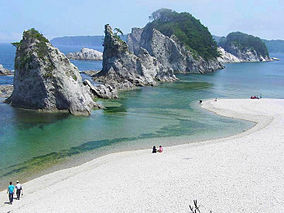Sanriku Fukkō National Park
| Sanriku Fukkō National Park | |
|---|---|
| 三陸復興国立公園 | |
IUCN category II (national park) | |
 Jōdogahama in 2007 (Place of Scenic Beauty)[1] | |
| Location | Tōhoku, Japan |
| Area | 28,537 hectares (110.18 sq mi) |
| Established | 24 May 2013[2] |
Sanriku Fukkō National Park (三陸復興国立公園, Sanriku Fukkō Kokuritsu Kōen) (lit. "Sanriku Reconstruction National Park") is a national park extending along the Sanriku Coast of Japan from Hachinohe in Aomori Prefecture through Iwate Prefecture to Kesennuma in Miyagi Prefecture. Created in 2013 in the aftermath of the 2011 Tōhoku earthquake and tsunami, it incorporates the former Rikuchū Kaigan National Park and Tanesashi Kaigan Hashikamidake Prefectural Natural Park. In 2014, the Ministry of the Environment plans to extend the park to include Minami Sanriku Kinkasan Quasi-National Park. Subsequently the park will be extended to include Kesennuma Prefectural Natural Park, Kenjōsan Mangokuura Prefectural Natural Park, and Matsushima Prefectural Natural Park.[2][3][4]At northern part of the national park there is a 8km long and 200m-high set of cliffs called the Kita Yamazaki; it is said to be Japan's most beautiful coastline.[5]
See also
| Wikimedia Commons has media related to Sanriku-Fukko National Park. |
- List of national parks of Japan
References
^ 浄土ヶ浜 [Jōdogahama] (in Japanese). Agency for Cultural Affairs. Archived from the original on 21 July 2012. Retrieved 22 October 2013..mw-parser-output cite.citation{font-style:inherit}.mw-parser-output q{quotes:"""""""'""'"}.mw-parser-output code.cs1-code{color:inherit;background:inherit;border:inherit;padding:inherit}.mw-parser-output .cs1-lock-free a{background:url("//upload.wikimedia.org/wikipedia/commons/thumb/6/65/Lock-green.svg/9px-Lock-green.svg.png")no-repeat;background-position:right .1em center}.mw-parser-output .cs1-lock-limited a,.mw-parser-output .cs1-lock-registration a{background:url("//upload.wikimedia.org/wikipedia/commons/thumb/d/d6/Lock-gray-alt-2.svg/9px-Lock-gray-alt-2.svg.png")no-repeat;background-position:right .1em center}.mw-parser-output .cs1-lock-subscription a{background:url("//upload.wikimedia.org/wikipedia/commons/thumb/a/aa/Lock-red-alt-2.svg/9px-Lock-red-alt-2.svg.png")no-repeat;background-position:right .1em center}.mw-parser-output .cs1-subscription,.mw-parser-output .cs1-registration{color:#555}.mw-parser-output .cs1-subscription span,.mw-parser-output .cs1-registration span{border-bottom:1px dotted;cursor:help}.mw-parser-output .cs1-hidden-error{display:none;font-size:100%}.mw-parser-output .cs1-visible-error{font-size:100%}.mw-parser-output .cs1-subscription,.mw-parser-output .cs1-registration,.mw-parser-output .cs1-format{font-size:95%}.mw-parser-output .cs1-kern-left,.mw-parser-output .cs1-kern-wl-left{padding-left:0.2em}.mw-parser-output .cs1-kern-right,.mw-parser-output .cs1-kern-wl-right{padding-right:0.2em}
^ ab 基礎情報 [Basic Information] (in Japanese). Ministry of the Environment. Archived from the original on 23 October 2013. Retrieved 22 October 2013.
^ "National park of restoration". The Japan Times. 28 May 2013. Retrieved 22 October 2013.
^ Katsuragawa Hiroki. "Green reconstruction through the creating a new Sanriku Fukko (reconstruction) National Park" (PDF). IUCN. Retrieved 22 October 2013.
[permanent dead link]
^ "About Kita Yamazaki - Iwate Travel Guide | Planetyze". Planetyze. Retrieved 2017-11-30.
External links
- Places of Interest in Sanriku Fukkō National Park
(in Japanese) Sanriku Fukkō National Park
Coordinates: 39°38′N 141°58′E / 39.633°N 141.967°E / 39.633; 141.967
